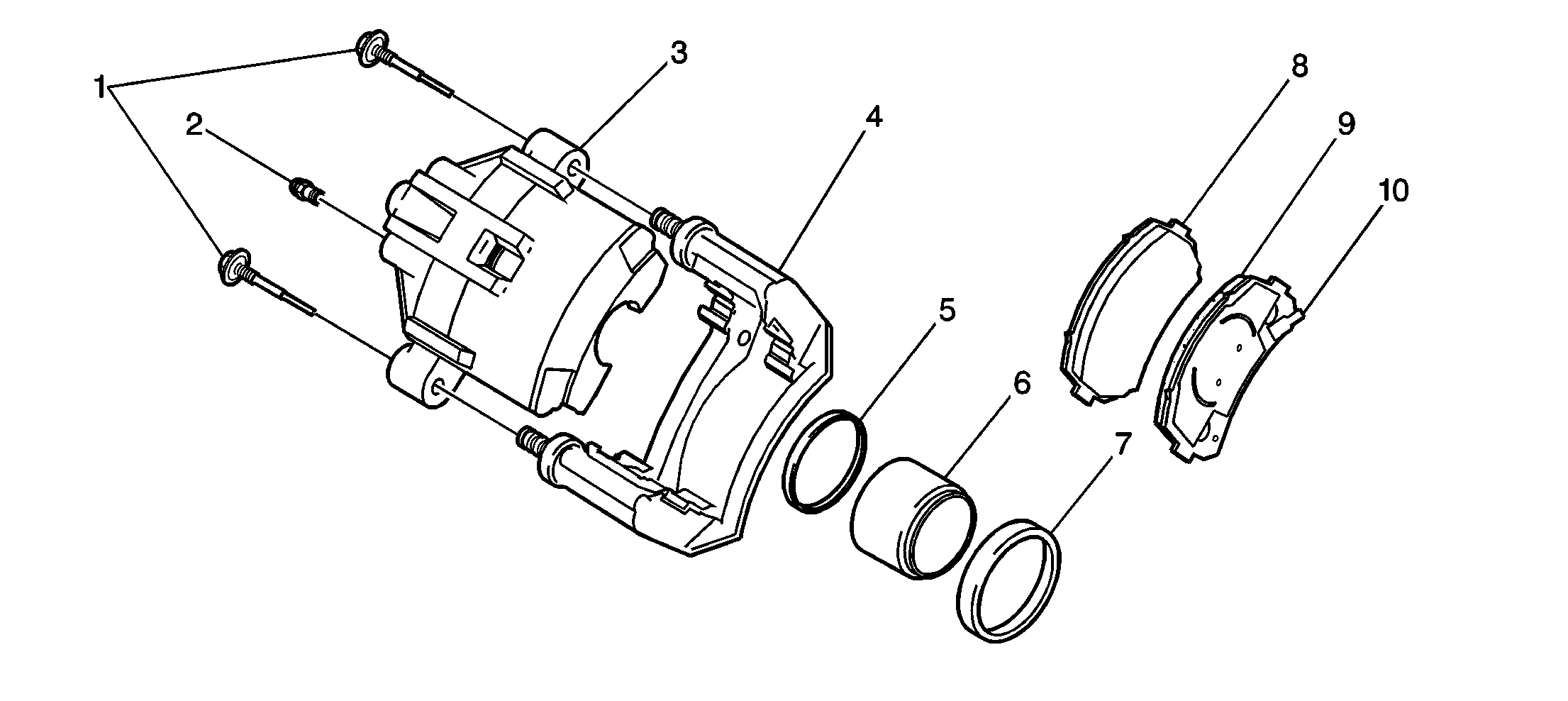
Important:
• There is an (RPO CODE JA9) heavy duty brake system for the Autobahn
package. The (RPO CODE JA9) heavy duty brake system visually looks,and is
repaired in the same manner as the (RPO CODE JB9) standard duty brake system
except that it is lagger in size than the (RPO CODE JB9) standard duty
brake system. Before servicing the brake system the (RPO CODE) must be checked
before any repairs are started. • Replace all the components included in repair kits that are used
to service this caliper. • Lubricate the rubber parts with clean brake fluid in order to
ease assembly. • Do not use lubricated compressed air on brakes. Doing so may damage
the rubber components. • Bleed the entire brake system whenever you remove any hydraulic
component. • Replace the brake pads in the axle sets only. • The specified torque values are for dry, non-lubricated fasteners. • Perform service operations on a clean bench.
The caliper used on this vehicle has a single bore. The caliper (3) mounts to the support bracket (4) with two mounting bolts (1). Fluid pressure behind the caliper piston increases when applying the brakes. Pressure exerts equally against the bottom of the piston (6) and the bottom of the piston bores. The pressure that applies to the piston transmits to the inner pad (8). The pressure forces the pad against the inner rotor surface. The pressure that applies to the bottom of the piston bores forces the caliper to slide on the mounting bolts. The caliper slides to the center of the vehicle. Because the caliper is one piece, the sliding movement causes the outer section of the caliper to apply pressure against the back of the outer pad (10). The pressure then forces the pad against the outer rotor surface. As line pressure builds, the pads press against the rotor surfaces with increased force. The force brings the vehicle to a stop. When releasing the brake pedal, the line pressure releases. The seal (5) and the seal groove cause the piston to retract slightly. Piston retraction causes less drag on the rotor by both pads. Outward movement of the piston and inward movement of the caliper automatically compensate for pad wear. As the pads wear, the increased area behind the piston fills with brake fluid from the master cylinder reservoir.
Refinishing Brake Rotors
Do not refinish brake rotors when performing routine brake maintenance, such as replacing worn disc brake pads. Refinish a rotor only under the following circumstances:
| • | There is a complaint of brake pulsation. |
| • | There is scoring greater than 1.5 mm (0.060 in). |
All of the brake rotors have a minimum thickness dimension cast into them. This dimension is a minimum wear dimension, not a refinishing dimension. Do not use a brake rotor that, after refinishing, will not meet the specifications shown on the rotor. Use a new rotor.
Accurate control of the rotor tolerance is necessary for proper performance of the disc brakes. Use only precision equipment in order to machine the rotor. Service the machining equipment on a regular basis. Follow the manufacturer's recommended maintenance procedure.
The following tool accessories must be in good condition when refinishing rotors:
| • | Attaching adapters |
| • | Tool holders |
| • | Vibration dampeners |
| • | Tool bits |
Always use sharp cutting tools and bits. Use only replacement cutting bits recommended by the equipment manufacturer. Dull or worn tools leave a poor surface finish which will affect braking performance. Always use vibration dampening attachments when refinishing braking surfaces. The attachments eliminate tool chatter and will result in a better surface finish. Ensure that the adapters are clean and free of nicks.
For best results, use an on-vehicle brake lathe whenever you are refinishing a rotor in order to correct a problem with brake pulsation. Follow the equipment manufacturer's recommended specifications and procedure.
